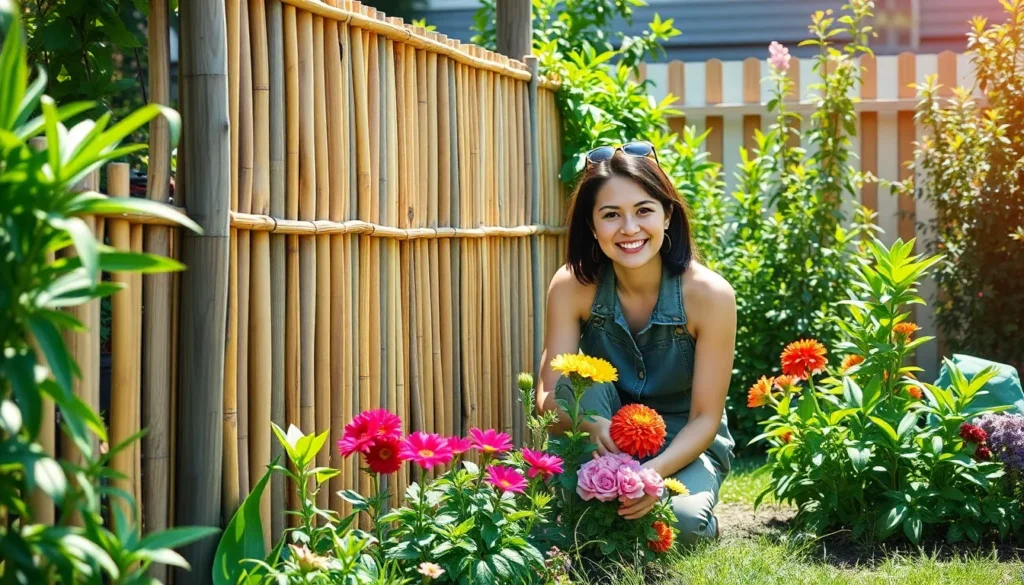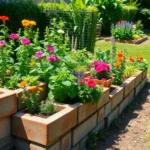Creating beautiful garden boundaries doesn’t have to drain your wallet. We’ve discovered that stunning fences can be built on practically any budget with the right materials and a bit of creativity. Whether you’re looking to define planting areas protect your vegetables from critters or add privacy to your outdoor space affordable answers exist for every gardening need.
From repurposed pallets to bamboo screens and living hedges we’ll show you how to transform inexpensive materials into attractive functional fencing. These budget-friendly options prove that you don’t need to spend hundreds of dollars to achieve the garden borders you’ve been dreaming of.
The best part? Most of these DIY fence ideas require minimal tools and can be completed over a weekend. We’ve tested these methods ourselves and found them to be both cost-effective and surprisingly durable when properly installed.
Budget-Friendly Bamboo Fencing Options
We can transform our garden boundaries with bamboo answers that offer exceptional value without sacrificing natural beauty. These versatile materials provide privacy, protection, and aesthetic appeal at a fraction of traditional fencing costs.
Natural Bamboo Roll Fencing
Natural bamboo roll fencing delivers the most cost effective option for covering large areas quickly. We’ll find these rolls at home improvement stores for $40 to $80 per 50 foot section, making them significantly cheaper than individual bamboo panels or custom installations.
Bamboo rolls adapt to various terrain types including slopes, curves, and uneven ground that rigid panels can’t accommodate. Installation requires only basic tools like zip ties, wire, or bamboo clips to secure the rolls to existing fence posts or stakes.
Quality varies between manufacturers, with thicker bamboo canes lasting 5 to 7 years in most climates. We can expect premium rolls with 1 inch diameter canes to withstand wind and weather better than thinner alternatives that may split or fade within 2 to 3 seasons.
Rolling out these screens creates instant privacy barriers reaching heights of 4 to 8 feet depending on our exact needs. The natural spacing between bamboo canes allows air circulation while blocking most sightlines from neighboring properties.
DIY Bamboo Panel Installation
DIY bamboo panel projects reduce material costs by up to 60% compared to hiring professional installers. We can purchase individual bamboo poles for $3 to $8 each at garden centers or online suppliers, then construct custom panels sized for our exact garden layout.
Creating panels requires connecting bamboo poles with galvanized wire, zip ties, or traditional lashing techniques using natural fiber rope. Spacing poles 4 to 6 inches apart provides adequate coverage while maintaining the airy feel that makes bamboo fencing so appealing.
Pre drilling pilot holes prevents bamboo from splitting when we attach panels to wooden posts or metal stakes. Standard wood screws or galvanized bolts work well for permanent installations, while removable clips allow seasonal adjustments or relocations.
Building panels in 6 to 8 foot sections makes handling easier during installation and replacement. We can complete most panel installations using a cordless drill, level, and measuring tape without requiring specialized equipment or advanced carpentry skills.
Treatment with bamboo sealers or natural oils extends panel life by protecting against moisture and UV damage. Regular maintenance every 2 to 3 years keeps our DIY bamboo fencing looking fresh while maximizing our initial investment.
Repurposed Pallet Wood Fence Designs
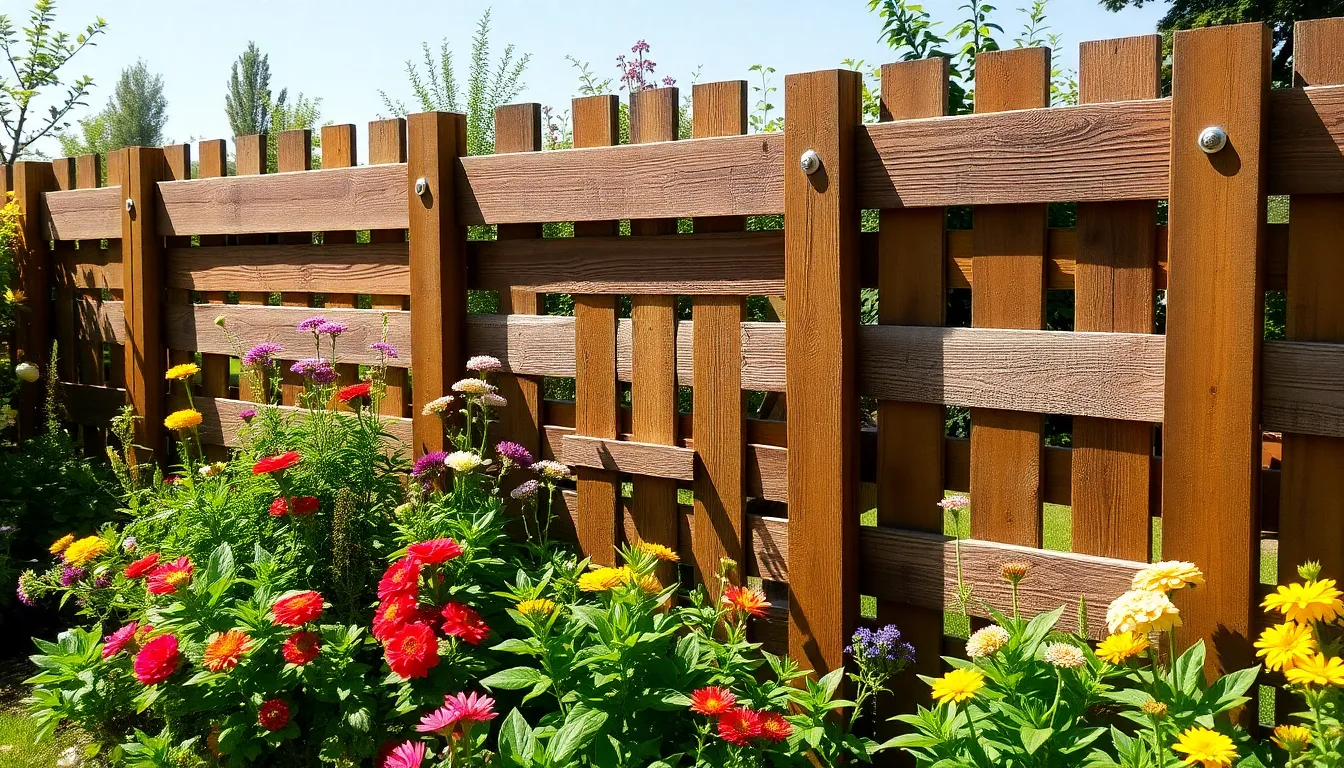
Pallets offer one of the most budget-friendly approaches to garden fencing, with many available for free from nurseries and construction sites. We can transform these discarded materials into attractive barriers that rival expensive store-bought options.
Horizontal Pallet Fence Layout
Collecting and preparing pallets starts our horizontal fence project with gathering uniform-sized pallets from local businesses. We should look for pallets marked with the International Plant Protection Convention (IPPC) logo to ensure they’re safe for garden use.
Installing vertical posts requires spacing them at regular intervals that match our pallet dimensions. We dig post holes approximately 2 feet deep and secure the posts with concrete for maximum stability.
Securing pallets horizontally between posts creates a sturdy barrier by positioning each pallet flat against the support posts. We use 3-inch exterior screws or galvanized nails to attach pallets firmly to the posts at multiple points.
Adding finishing touches includes installing a top rail across the entire fence line for extra stability and visual appeal. We can stain or paint the completed fence to match our garden’s aesthetic while protecting the wood from weather damage.
Vertical Pallet Privacy Screen
Preparing pallet strips involves cutting whole pallets into individual slats or using them intact for a more rustic appearance. We sort the pieces by size and condition to ensure consistent spacing throughout our privacy screen.
Setting vertical posts requires measuring precise intervals based on our pallet width to create seamless sections. We position posts slightly wider than standard spacing to accommodate the vertical pallet orientation.
Stacking pallet materials vertically between posts builds an effective privacy barrier by overlapping edges for complete coverage. We secure each pallet strip or whole pallet section using exterior screws driven into the support posts.
Reinforcing the structure involves adding horizontal support rails behind the vertical pallets for enhanced durability. We can create this DIY garden fence for under $30 using basic materials while achieving professional-looking results that withstand various weather conditions.
Chicken Wire and Post Combinations
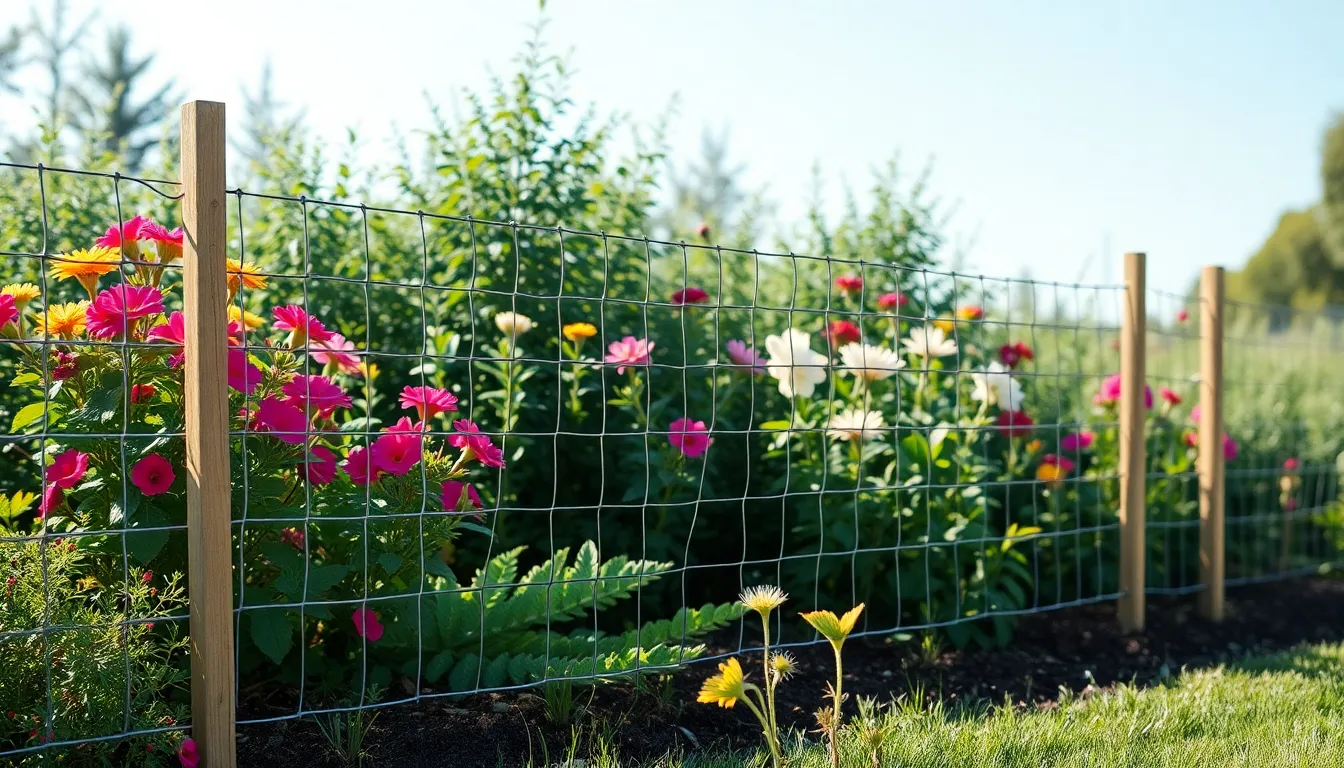
Chicken wire offers one of the most affordable answers for garden fencing, combining practicality with easy installation. This versatile material works perfectly for protecting plants while maintaining clear sightlines throughout your garden space.
Basic Chicken Wire Garden Border
Basic chicken wire garden borders provide the most cost-effective fencing solution for gardeners on tight budgets. We recommend using chicken wire with wooden stakes or thin posts to create simple yet effective boundaries around your planting areas.
Installing this budget-friendly option requires minimal materials and tools. You’ll need chicken wire rolls, wooden stakes, wire cutters, and a hammer or post driver for installation. The total cost remains very low due to chicken wire’s affordable pricing compared to other fencing materials.
Securing the wire becomes straightforward when you install wooden stakes at 6-foot intervals along your desired fence line. Unroll the chicken wire and attach it to each stake using wire ties or staples, ensuring the bottom edge sits flush with the ground to prevent small animals from crawling underneath.
Maintenance stays minimal with this simple design, requiring only occasional tightening of loose sections and replacement of damaged wire areas. The lightweight nature of chicken wire makes repairs quick and inexpensive throughout the growing season.
Decorative Wire Mesh with Wooden Posts
Decorative wire mesh with wooden posts elevates the appearance of your garden fence while remaining budget-friendly. This option costs slightly more than plain chicken wire but delivers enhanced visual appeal and improved durability for long-term use.
Installing decorative wire mesh requires wooden posts, decorative wire mesh panels, wire cutters, and a staple gun for secure attachment. The materials offer better resistance to stretching and sagging compared to standard chicken wire, making them ideal for areas with higher foot traffic or wind exposure.
Setting up this system involves installing wooden posts at regular intervals, typically 8 feet apart for optimal support. Attach the decorative wire mesh using a staple gun, ensuring consistent spacing between staples for even tension distribution across each panel.
Customizing your decorative wire mesh fence allows for creative expression through various mesh patterns and post treatments. You can paint or stain the wooden posts to match your garden’s aesthetic while choosing from different wire mesh designs to complement your industry style.
Living Fence Solutions Using Plants
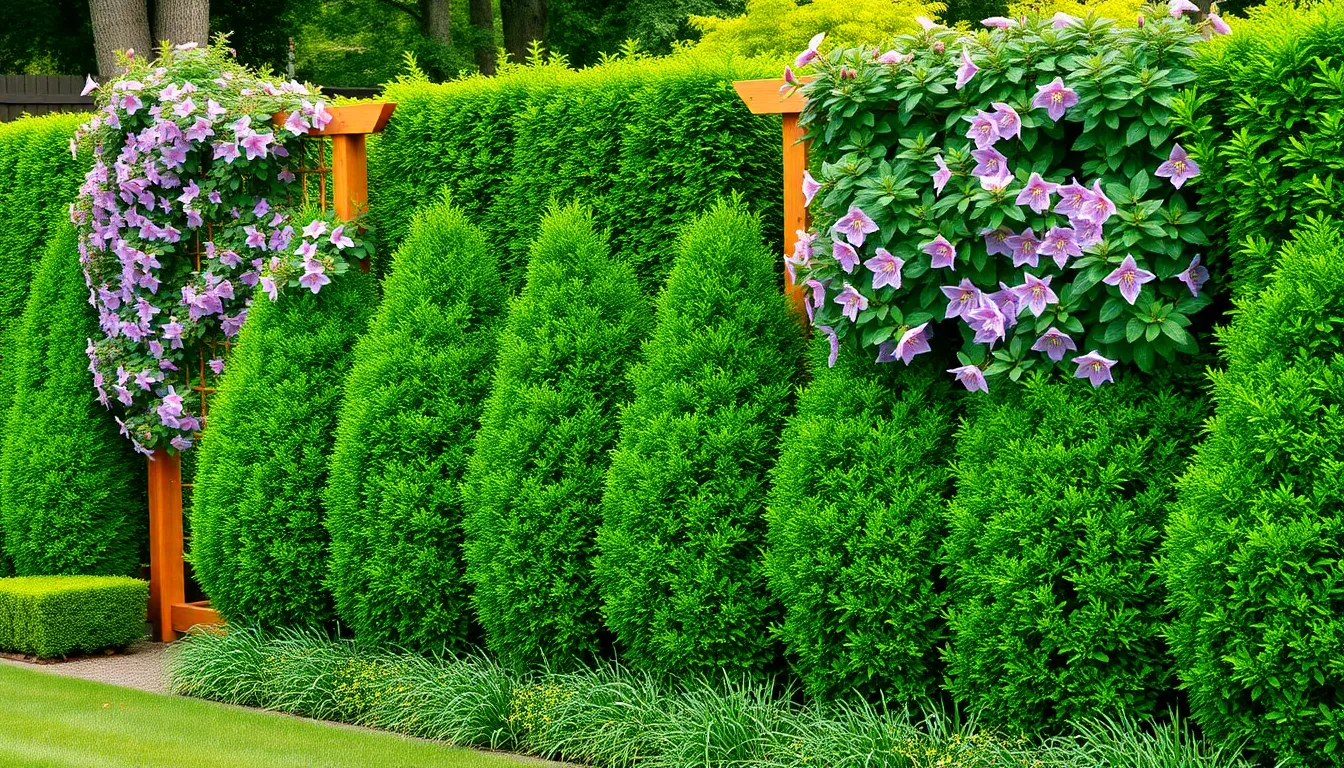
Living fences offer the most sustainable and cost-effective approach to garden boundaries while providing year-round privacy and natural beauty.
Fast-Growing Hedge Plants
Boxwood hedges create dense, formal borders that require minimal maintenance once established. We recommend planting these evergreen shrubs 2-3 feet apart for optimal coverage within 18 months. Boxwood varieties like ‘Green Velvet’ and ‘Winter Gem’ tolerate pruning well and maintain their shape throughout all seasons.
Privet hedges grow rapidly and cost significantly less than traditional fencing materials. These hardy plants can reach 6-8 feet in height within 2-3 years when planted correctly. Common privet (Ligustrum vulgare) thrives in various soil conditions and requires pruning twice yearly to maintain desired thickness.
Arborvitae plants provide excellent privacy screening at a fraction of professional installation costs. Emerald Green arborvitae grows 12-24 inches annually and creates a natural windbreak for garden protection. We suggest spacing these evergreens 3-4 feet apart for complete coverage within three growing seasons.
Climbing Vine Support Systems
Wooden stake trellises support climbing vines like ivy and clematis for under $25 per 8-foot section. We install 6-foot cedar stakes every 4 feet and connect them with galvanized wire or wooden slats. This system allows vines to establish quickly while providing immediate structure for garden boundaries.
Clematis vine installations transform basic support structures into stunning living walls within one growing season. Popular varieties like ‘Jackmanii’ and ‘Nelly Moser’ produce abundant blooms and require minimal care once rooted. We recommend planting clematis 18 inches apart along trellis systems for maximum coverage.
English ivy systems cover existing fences or structures completely within 2-3 years of planting. This evergreen vine adapts to shade conditions and requires only annual pruning to control growth. Ivy installations cost approximately $3-5 per linear foot including support materials and plants.
Recycled Material Fence Ideas
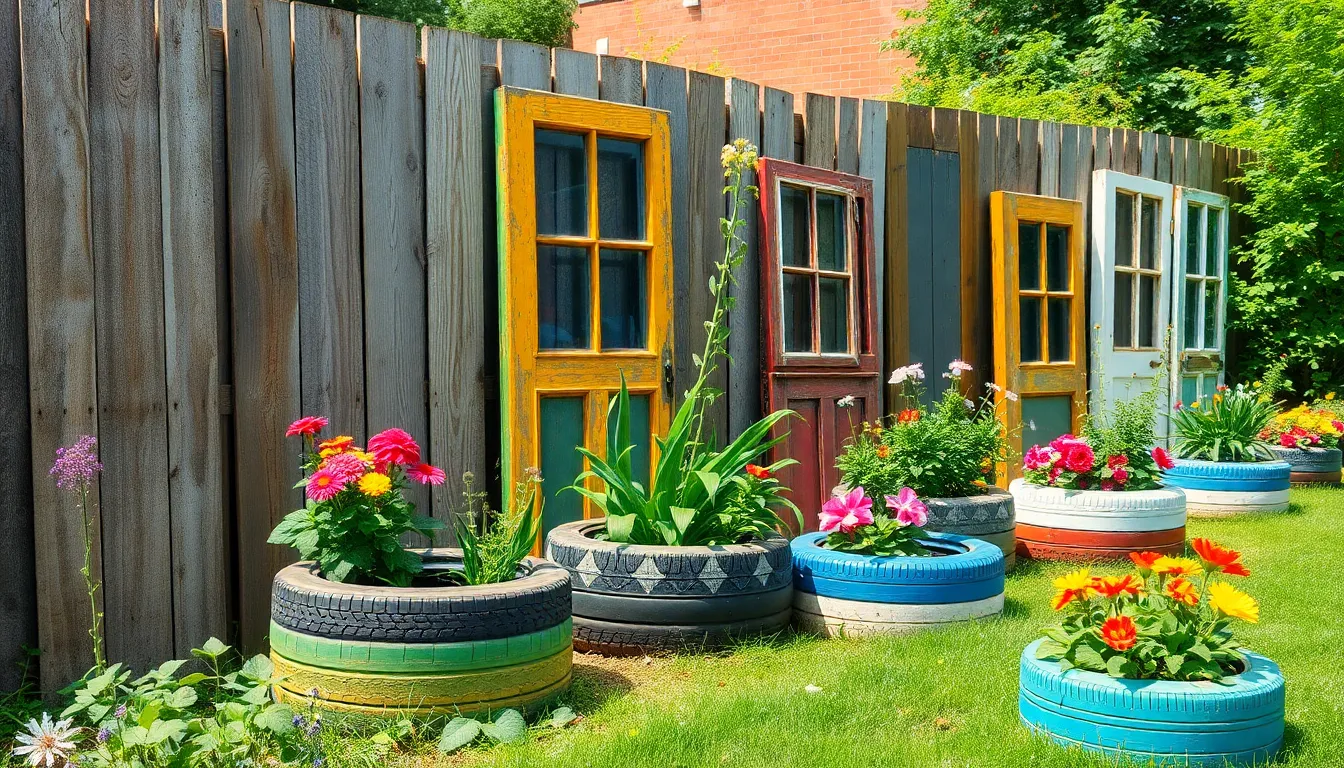
We can transform discarded materials into stunning garden barriers that rival expensive store-bought options. These creative approaches help us reduce waste while building beautiful boundaries for our outdoor spaces.
Old Door and Window Frame Fencing
Salvaged doors and window frames create charming garden fences with unique character and vintage appeal. We can attach these architectural elements to wooden posts or frames for sturdy support that withstands weather conditions. This method reduces waste by giving new life to materials that would otherwise end up in landfills.
Benefits of using old doors and windows include:
- Instant decorative appeal without additional design elements
- Built-in structure that requires minimal modifications
- Cost savings of up to 70% compared to new fencing materials
- Weather-resistant properties when properly treated
Installation involves securing the frames to wooden posts using galvanized screws or brackets. We recommend spacing posts 6 to 8 feet apart for optimal stability. Adding a weatherproof sealant helps protect the wood and extends the fence’s lifespan.
Tire Planter Fence Borders
Used tires transform into functional planters that double as attractive garden borders. We arrange these tire planters along our garden perimeter to create a lush, green barrier that serves multiple purposes. Each tire holds approximately 2 cubic feet of soil, providing ample growing space for various plants.
Setup process for tire planter fences:
- Position tires in desired locations along the border
- Fill each tire with quality potting soil or compost mixture
- Plant flowers, herbs, or small shrubs inside each tire
- Water regularly to establish healthy plant growth
This approach costs roughly $5 to $10 per tire planter compared to $20 to $30 for traditional planters. We can paint the tires in coordinating colors to match our garden’s aesthetic. Popular plant choices include marigolds, petunias, herbs like basil and oregano, or small vegetables such as lettuce and radishes.
Chain Link Fence Budget Alternatives
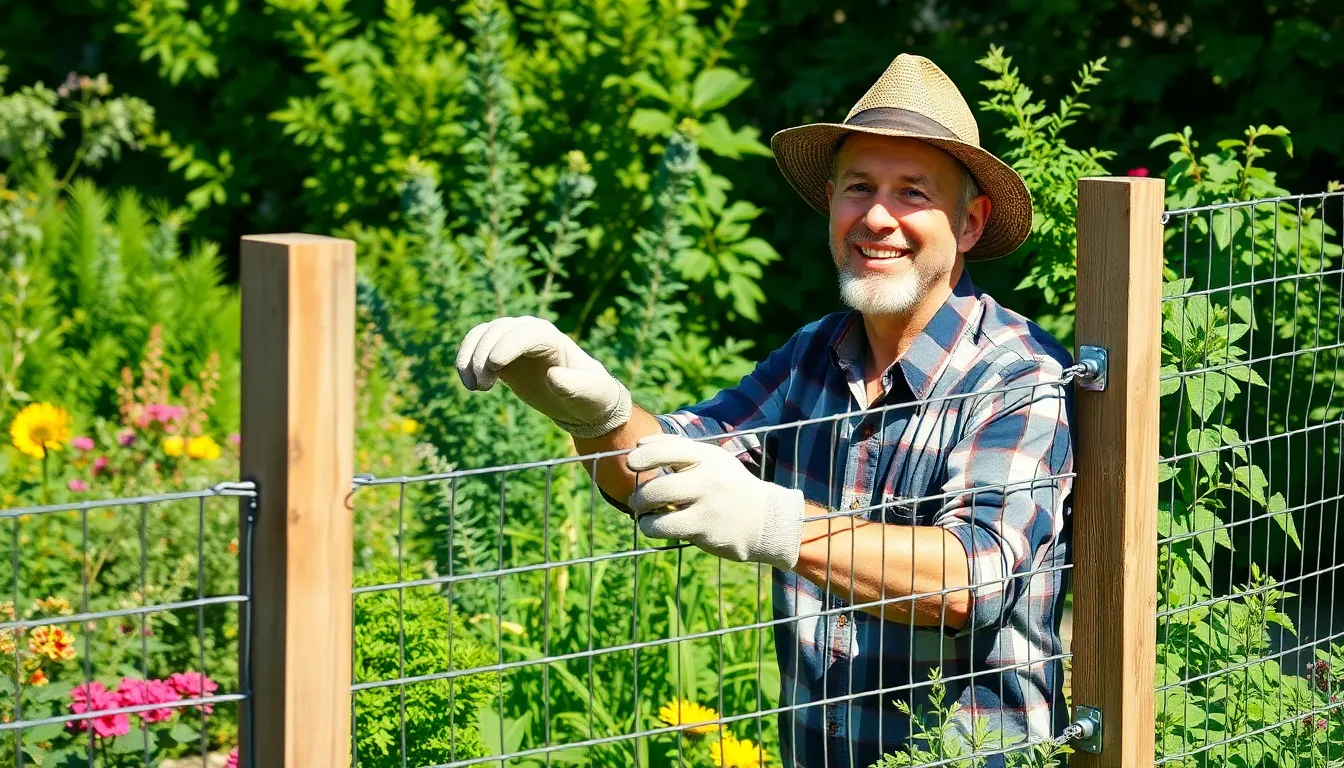
Chain link fencing provides excellent security but comes with hefty price tags that make many gardeners seek more affordable options. We’ve identified several cost-effective alternatives that deliver similar protection while keeping your budget intact.
Welded Wire Mesh Panels
Welded wire mesh panels offer one of the most economical answers for garden perimeter protection. These panels cost significantly less than traditional chain link fencing while providing comparable durability and security features.
Installation becomes remarkably straightforward with these prefabricated panels that come in standard 6-foot by 8-foot sections. We can attach them directly to wooden posts using galvanized screws or heavy-duty zip ties. Assembly requires only basic tools like a drill, level, and post-hole digger.
Versatility stands out as these panels adapt to various garden layouts and terrain changes. We can cut them to custom sizes using bolt cutters or angle grinders when working around obstacles or creating unique configurations.
Maintenance demands minimal effort since the welded construction resists sagging and provides long-term stability. These panels typically last 10-15 years with proper installation and occasional cleaning.
Livestock Panel Fencing
Livestock panels deliver exceptional strength and durability at prices well below traditional fencing materials. These heavy-gauge welded wire panels originally designed for containing farm animals provide robust garden protection.
Construction features 4-gauge to 6-gauge wire that creates incredibly sturdy barriers capable of withstanding high winds and animal pressure. We can expect these panels to handle impacts that would damage lighter fencing materials.
Standard dimensions include 16-foot lengths that reduce the number of posts needed for installation. This configuration cuts labor time and material costs compared to shorter panel systems.
Installation flexibility allows multiple mounting options including T-posts, wooden posts, or metal corner posts depending on your exact needs and budget constraints. We can secure panels using clips, bolts, or heavy-duty wire ties.
Cost effectiveness becomes apparent when comparing coverage area to material investment. A single livestock panel covers the same area as multiple smaller welded wire sections while providing superior structural integrity.
Simple Wood Picket Fence Options

Wood picket fences remain one of our most popular recommendations for creating affordable garden boundaries. These traditional designs offer excellent value while providing the classic charm that complements any garden style.
Pine Board Picket Design
Pine board picket fences deliver exceptional value for budget-conscious gardeners seeking traditional appeal. We recommend this design because it combines affordability with timeless visual appeal that enhances any garden space.
Cost-effective materials make pine the go-to choice for DIY fence projects. Pine boards typically cost 30-50% less than premium wood options, allowing you to cover more ground within your budget. The boards are readily available at most home improvement stores in standard lengths.
Installation simplicity makes this design perfect for weekend DIY projects. Pine boards are lightweight and easy to cut, requiring only basic tools like a circular saw and drill. We’ve found that most homeowners can complete a 50-foot section in one weekend.
Customizable spacing allows you to adapt the fence to your exact needs. Traditional picket fences feature boards spaced 2-3 inches apart, but you can adjust this based on your privacy requirements. Closer spacing provides more privacy while wider gaps reduce material costs.
Horizontal rail attachment provides the structural foundation for your picket fence. Two horizontal rails per section offer adequate support for most garden applications. We recommend using galvanized screws rather than nails for better long-term durability.
Cedar Picket Maintenance Tips
Cedar picket fences require exact maintenance approaches to maximize their natural durability advantages. We’ve developed these proven techniques to help you protect your investment and extend fence lifespan.
Regular cleaning schedules prevent dirt buildup that can trap moisture against the wood. Mix mild detergent with water and apply using a soft brush every 6-8 months. This simple routine removes accumulated grime without damaging the cedar’s natural oils.
Waterproof sealant application protects cedar from moisture damage and UV deterioration. Apply a high-quality wood sealant every 2-3 years, focusing on cut ends and joints where moisture typically penetrates. We recommend testing the sealant on a small section first to ensure color compatibility.
Damage inspection routines help you catch problems before they become expensive repairs. Check for soft spots, insect holes, or discoloration monthly during growing season. Early detection allows for targeted treatment rather than board replacement.
Proper drainage maintenance prevents water from pooling around fence posts and boards. Clear vegetation and debris from the fence base regularly to promote air circulation. We’ve seen cedar fences last 15-20 years with proper drainage compared to 8-10 years without it.
Creative PVC Pipe Fence Projects
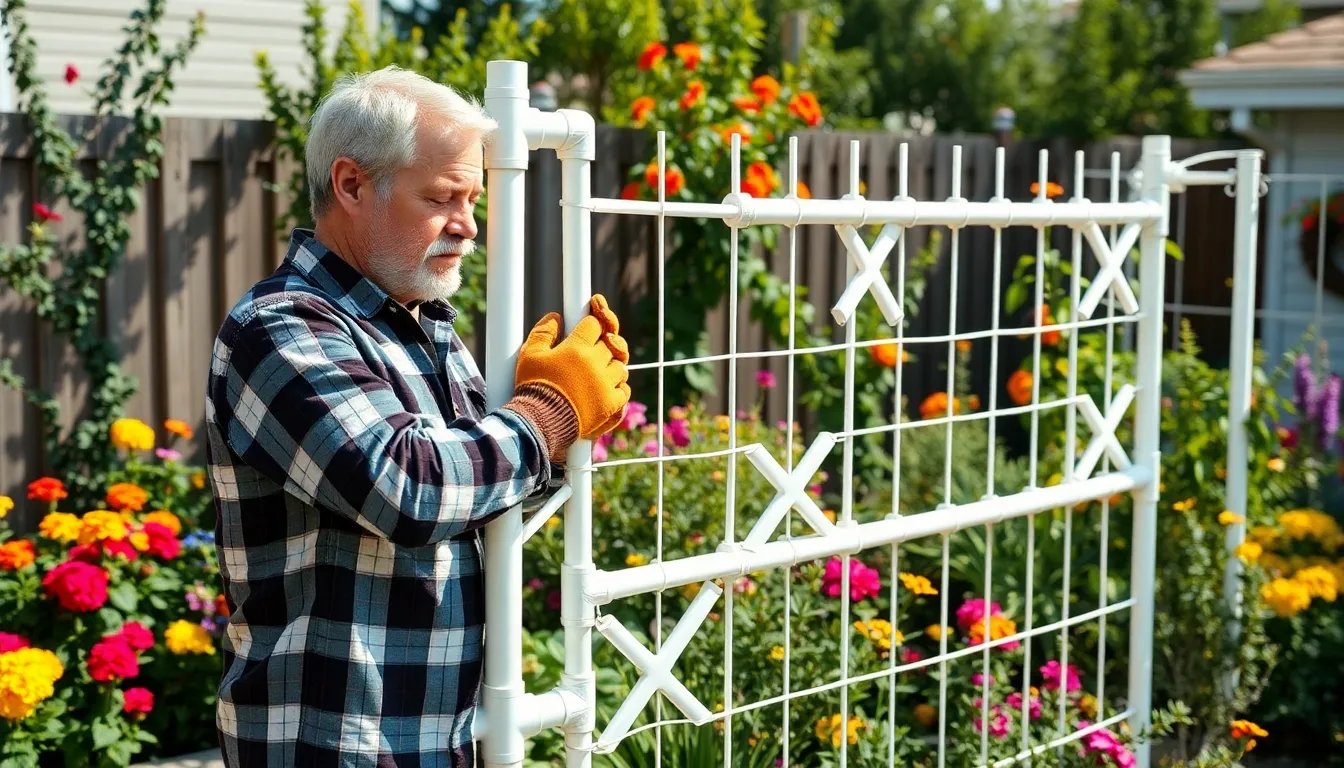
PVC pipes offer one of the most versatile and budget-friendly materials for garden fencing projects. We’ll explore how these lightweight, weather-resistant pipes can transform your garden boundaries with minimal investment and maximum creativity.
Basic PVC Rail Fencing
Schedule 40 PVC pipes provide the ideal strength foundation for rail fencing systems that won’t rot or rust like traditional materials. We recommend using T and elbow connectors to attach horizontal rails between vertical posts, creating a clean and professional appearance.
Assembly requires only basic tools including a handsaw and drill, making this project accessible for weekend DIY enthusiasts. We can adjust pipe lengths to create privacy barriers or low decorative borders that perfectly define garden beds and walkways.
Installation speed sets PVC rail fencing apart from other materials since no specialized equipment is needed beyond standard cutting and drilling tools. We appreciate how these fences can be disassembled for seasonal storage, offering flexibility that permanent installations can’t match.
Height customization allows us to tailor the fence to exact garden needs, whether we’re creating subtle boundary markers or more substantial barriers for vegetable protection.
Decorative PVC Lattice Panels
Interlaced PVC strips create stunning visual appeal when arranged in geometric patterns or combined with premade lattice panels for faster installation. We can paint these panels in colors that complement our garden themes, from natural earth tones to vibrant accent shades.
Functionality extends beyond aesthetics as these panels offer partial privacy while supporting climbing plants like ivy, clematis, or morning glories that transform the fence into a living wall.
Construction involves attaching panels to PVC or wooden posts using zip ties or outdoor adhesive for secure, weather-resistant installation. We find this method particularly effective for creating garden room dividers or screening utility areas.
Maintenance requirements remain minimal with occasional cleaning being the primary upkeep task, while the material’s natural resistance to weather and pests eliminates concerns about rot, rust, or insect damage that plague traditional fencing materials.
Rope and Post Rustic Fencing
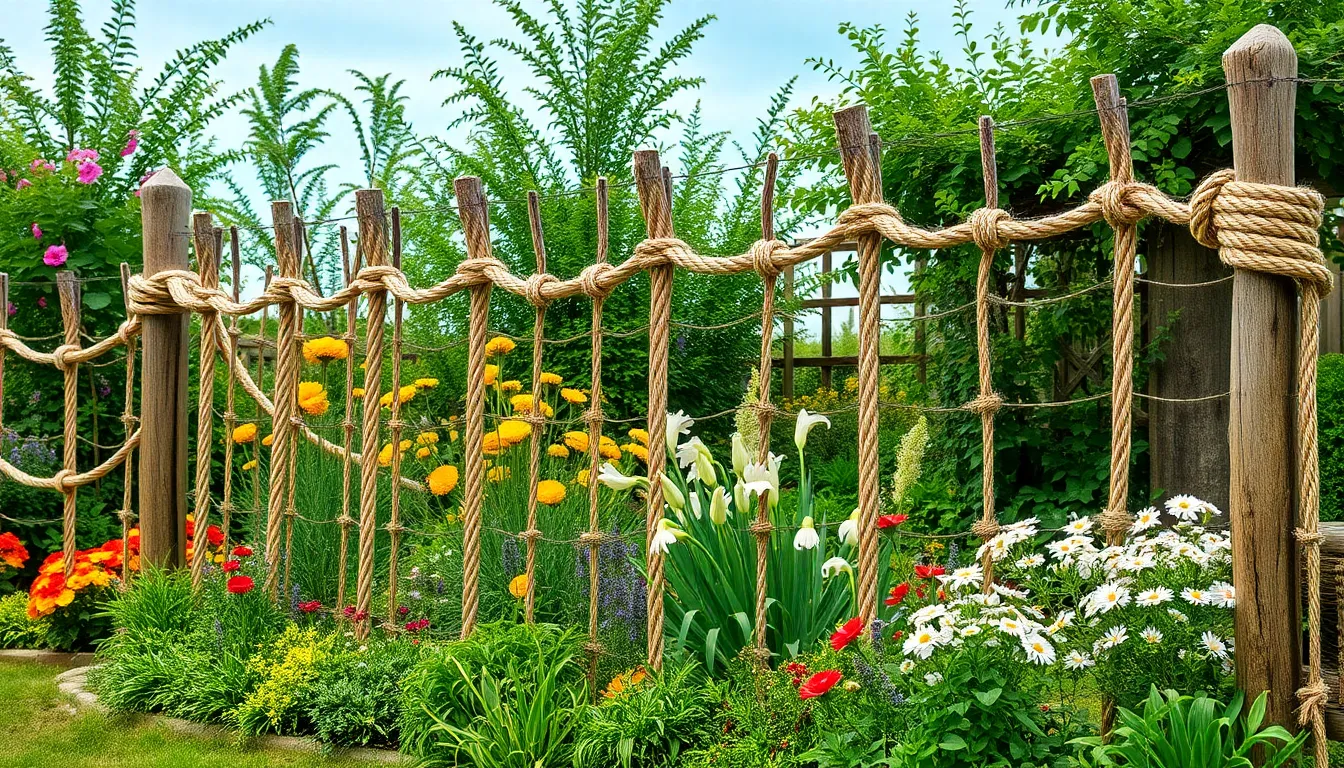
Rope and post fencing creates an affordable rustic charm that perfectly complements organic garden designs. We’ll explore how natural fiber materials can provide both functionality and aesthetic appeal for your garden boundaries.
Natural Fiber Rope Installation
Natural fiber ropes like jute or sisal offer durability and eco-friendly benefits for garden fencing projects. We recommend starting with 3/8-inch diameter rope for optimal strength and visual appeal. Installation begins by measuring the distance between your posts and adding 6 inches for proper wrapping and securing.
Wrapping techniques determine both the fence’s stability and appearance. We suggest using the cross-wrap method, where rope passes over and under each rail section, creating natural tension points. Secure each rope section using heavy-duty outdoor twine or galvanized wire at connection points.
Weather resistance becomes crucial for long-term performance. We treat natural fiber ropes with beeswax or marine-grade sealant before installation to extend their lifespan. This protective coating helps repel moisture while maintaining the rope’s natural texture and color.
Wooden Post Anchoring Methods
Wooden post anchoring ensures your rope fence remains stable through seasons and weather conditions. We recommend digging holes that measure one-third the height of your above-ground post depth. For example, a 6-foot fence requires 2-foot deep holes for optimal stability.
Concrete anchoring provides the strongest foundation for rope fencing systems. We mix one part Portland cement with three parts gravel for proper drainage around the post base. Quick-set concrete works well for smaller posts, while traditional concrete offers superior long-term stability for corner and gate posts.
Stakes provide additional support during the concrete curing process. We place temporary braces at 45-degree angles to keep posts perfectly vertical while concrete sets. Remove these stakes after 24 hours for quick-set concrete or 48 hours for traditional concrete mixtures.
Drainage considerations prevent post rot and extend fence life significantly. We create a 4-inch gravel base below each post before adding concrete, allowing water to drain away from the wood. This simple step can double the lifespan of your wooden posts in most soil conditions.
Corrugated Metal Sheet Fencing
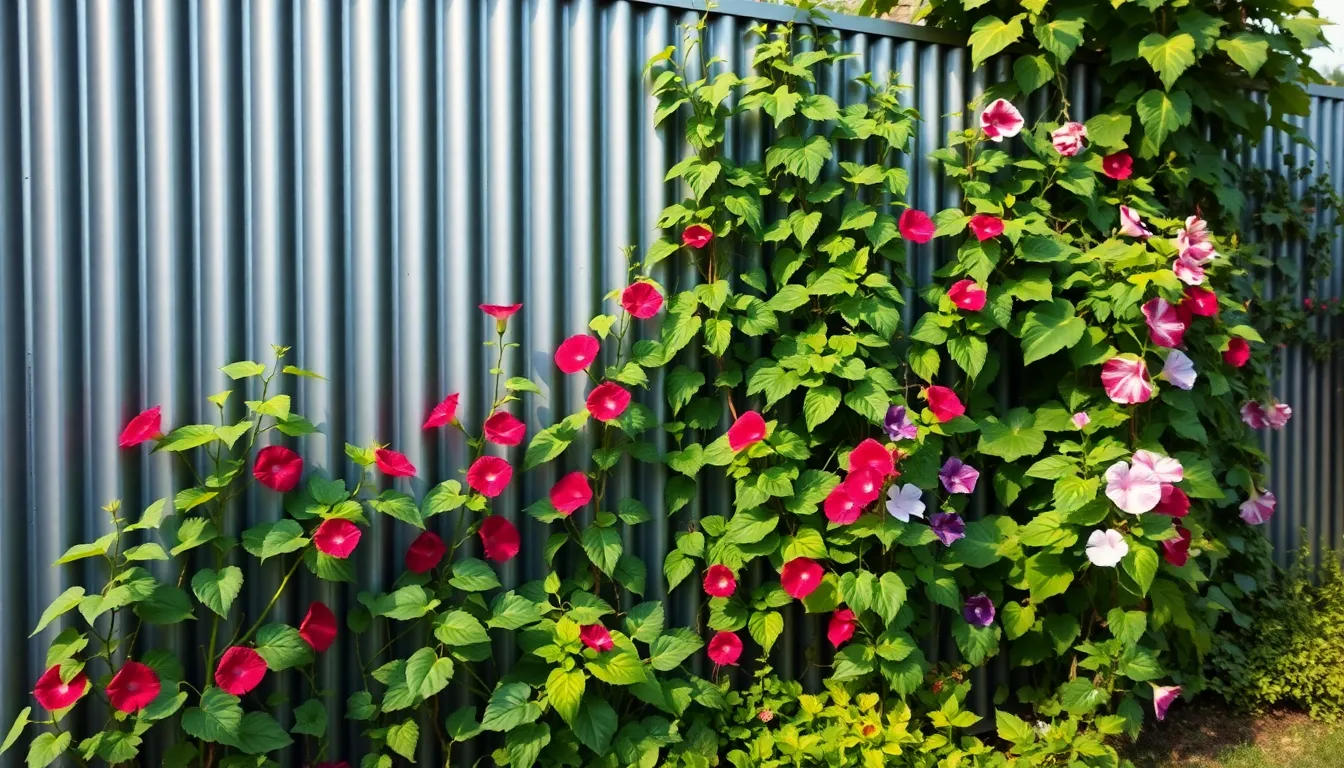
Corrugated metal sheets transform from basic roofing material into stunning garden fencing that delivers both durability and style. We’ve found these sheets offer exceptional value at $3 to $8 per linear foot while providing wind resistance and long-term protection for garden spaces.
Industrial Style Metal Panels
Industrial metal panels bring modern aesthetics to garden boundaries using steel, aluminum, or recycled materials in grid-like or modular designs. We prefer these panels because they’re lightweight yet sturdy, making installation straightforward even for weekend DIY projects. Grid designs allow climbing plants like ivy or morning glories to weave through openings, creating natural privacy screens that blend industrial charm with organic beauty.
Paint or powder coating options let us customize panels to match existing garden décor, from sleek black finishes to earth-tone colors. Aluminum panels resist corrosion naturally, while steel options provide maximum strength for areas needing enhanced security. Installation requires basic tools and wooden or metal posts spaced 6 to 8 feet apart for optimal support.
Rust Prevention Techniques
Surface preparation forms the foundation of effective rust prevention, starting with thorough cleaning to remove dirt, grease, and manufacturing residue. We recommend using degreasing agents followed by wire brush treatment for any existing rust spots before installation begins.
Galvanized panels offer built-in protection through zinc coating that prevents moisture from reaching the underlying metal. For non-galvanized options, rust-inhibiting primer creates a protective barrier that bonds directly to the metal surface. Exterior-grade paint serves as the final defense layer, with acrylic or polyurethane formulations providing superior weather resistance.
Regular maintenance involves annual inspections for scratches, chips, or worn areas where moisture might penetrate the protective coating. Touch-up paint applied promptly to damaged spots prevents rust from spreading throughout the panel. Proper drainage around fence posts prevents water accumulation that accelerates corrosion in buried sections of the fencing system.
Conclusion
Creating an attractive garden fence doesn’t have to drain your wallet. We’ve explored many budget-friendly options that prove you can achieve both functionality and style without compromising on quality.
From repurposed pallets and bamboo screens to living hedges and creative PVC projects these answers demonstrate that smart material choices and DIY enthusiasm can deliver professional-looking results. Each option we’ve covered offers unique benefits whether you’re seeking privacy wind protection or simply want to define your garden spaces.
The key to success lies in matching your fence choice to your exact needs and skill level. With basic tools and weekend dedication you can transform your garden boundaries while keeping costs under control. These affordable fencing ideas will serve you well for years to come.
Frequently Asked Questions
What is the most cost-effective material for DIY garden fencing?
Repurposed pallet wood is one of the most budget-friendly options, with projects costing under $30. Chicken wire with wooden stakes is another extremely affordable choice. Bamboo roll fencing offers good value at $40-$80 per 50-foot section, while DIY bamboo panels can reduce costs by up to 60% compared to professional installation.
How long does it take to install budget garden fencing?
Most DIY garden fencing projects can be completed in a weekend using basic tools. Simple installations like chicken wire borders or pallet fences require minimal time, while more complex projects like bamboo panels or living hedges may take slightly longer but are still achievable for beginners.
Are recycled materials safe for garden fencing?
Yes, when chosen carefully. Look for pallets marked with the IPPC logo to ensure they’re safe for garden use. Salvaged doors and window frames can be repurposed effectively. Old tires make excellent planters and borders. Always inspect recycled materials for damage, rust, or harmful chemicals before use.
What plants work best for living fence boundaries?
Fast-growing hedge plants like boxwood, privet, and arborvitae provide excellent year-round privacy and natural beauty. For climbing vine systems, ivy and clematis work well with wooden stake trellises. These plants create sustainable, cost-effective boundaries that improve over time while adding ecological value to your garden.
How do I maintain bamboo fencing to extend its lifespan?
Regular cleaning with mild soap and water prevents dirt buildup. Apply a protective sealant annually to resist weather damage. Check for loose connections and tighten hardware as needed. Replace damaged sections promptly to prevent further deterioration. Proper installation with adequate drainage helps prevent rot and extends overall fence life.
What tools are needed for DIY garden fencing projects?
Most projects require basic tools: hammer, drill, measuring tape, level, and saw. Specific materials may need additional tools like wire cutters for chicken wire or post-hole digger for wooden posts. PVC projects often only need a saw and drill, making them beginner-friendly options.
How much can I save with DIY fencing compared to professional installation?
DIY bamboo panels can save up to 60% compared to professional installation. Pallet and chicken wire fences offer even greater savings, often costing under $30 for materials. Most budget fencing solutions cost significantly less than hiring contractors, with savings ranging from 50-80% depending on the chosen material and design.
Are PVC pipe fences durable enough for garden use?
Yes, Schedule 40 PVC pipes are weather-resistant and lightweight, making them ideal for garden fencing. They resist rust, rot, and insects while being easy to install and maintain. PVC fences can be customized for height and design, and decorative lattice panels can support climbing plants effectively.
How do I prevent rust on metal garden fencing?
Use galvanized panels when possible, as they’re pre-treated for rust resistance. For existing metal fencing, clean the surface thoroughly, apply rust-preventive primer, and use weather-resistant paint. Regular maintenance including cleaning and touch-up painting extends the fence’s lifespan significantly. Consider corrugated metal sheets for better wind resistance.
What’s the best budget alternative to chain link fencing?
Welded wire mesh panels offer similar security and durability at a lower cost while being easier to install. Livestock panels provide another strong, affordable option originally designed for farm animals but excellent for garden protection. Both alternatives offer good value and can be customized for specific garden needs.

